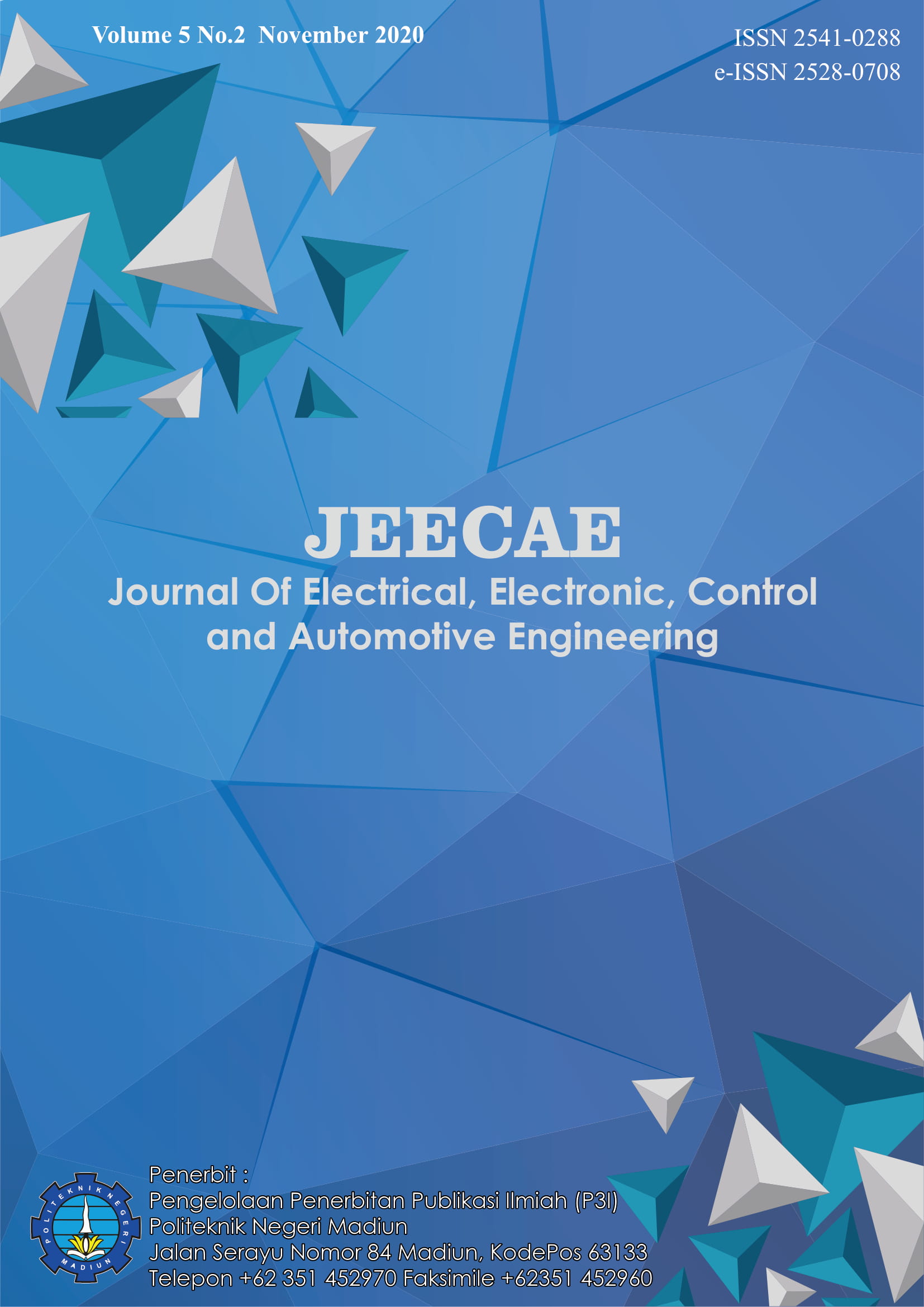Analisis Kekuatan Rangka Sepeda Statis Upper and Lower body Exercise untuk Terapi Pasien Pasca Stroke
DOI:
https://doi.org/10.32486/jeecae.v5i2.320Keywords:
Rangka, Simulasi, Tegangan, Sepeda StatisAbstract
Pemulihan pasien setelah mengalai stroke dapat dilakukan dengan terapi menggunakan bantuan alat fisioterapi berupa sepeda statis. Bentuk sepeda statis sangat bervariasi tergantung kebutuhan masing-masing pasien. Namun, belum ada alat fisioterapi yang secara sekaligus dapat melatih sisi atas (Upper) dan sisi bawah (Lower) dari tubuh pasien. Oleh karena itu, perancangan terhadap sepeda statis yang mampu melatih sisi upper dan lower tubuh pasien secara sekaligus di kemas dalam satu alat berupa sepeda statis. Analisa kekuatan rangka pada sepeda statis dilakukan secara teoritis dan secara simulasi. Material baja ST 37 dipilih sebagai rangka dengan tegangan geser maksimum sebesar 235 MPa. Sedangkan dari hasil simulai menggunakan perangkat lunak komersial diperoleh nilai tagangan maksimum sebesar 114,50 MPa. Nilai tersebut juga di bandingkan dengan nilai tegangan maksimum yang diperoleh secara teoritis, diperoleh nilai tegangan maksimum sebesar 103, 76 MPa. Nilai tersebut menunjukkan bahwa dari hasil pengujian rangka sepeda statis masih dalam katagori aman digunakan untuk beban pasien 100 Kg.
References
T. Asakawa, L. Zong, L. Wang, Y. Xia, and H. Namba, “Unmet challenges for rehabilitation after stroke in China,” Lancet, vol. 390, no. 10090, pp. 121–122, 2017.
D. Barbosa, C. P. Santos, and M. Martins, ―The application of cycling and cycling combined with feedback in the rehabilitation of stroke patients: A review,‖ J. Stroke Cerebrovasc. Dis., vol. 24, no. 2, pp. 253–273, 2015.
P. van Vliet and G. Wulf, ―Extrinsic feedback for motor learning after stroke: What is the evidence?,‖ Disabil. Rehabil., vol. 28, no. 13–14, pp. 831–840, 2006.
G. J. T. / B. Derrickson, PRINCIPLES OF ANATOMY AND PHYSIOLOGY 2014 – Tortora - 14th Ed. 2014.
A. S. Go et al., Heart Disease and Stroke Statistics—2013 Update, vol. 127, no. 1. 2013.
D. Risk, F. Of, and S. In, ―Faktor Risiko Dominan Penderita Stroke di Indonesia,‖ Bul.Penelit. Kesehat., vol. 44,No.1,Ma, pp. 49–58, 2015.
Pusat Data dan Informasi, ―Infodatin : Situasi Kesehatan Jantung,‖ Pus. Data dan Inf.Kementeri. Kesehat. RI, pp. 1–8, 2014.
M. S. Hossain, M. Hoda, G. Muhammad, A. Almogren, and A. Alamri, ―Cloud-supported framework for patients in post-stroke disability rehabilitation,‖ Telemat. Informatics, vol. 35, no. 4, pp. 826–836, 2018.
N. Shahar, I. Schwartz, and S. Portnoy, ―Differences in muscle activity and fatigue of the upper limb between Task-Specific training and robot assisted training among individuals post stroke,‖ J. Biomech., vol. 89, no. xxxx, pp. 28–33, 2019.
M. Trombetta, P. P. Bazzanello Henrique, M. R. Brum, E. L. Colussi, A. C. B. De Marchi, and R. Rieder, ―Motion Rehab AVE 3D: A VR-based exergame for post-stroke rehabilitation,‖ Comput. Methods Programs Biomed., vol. 151, pp. 15–20, 2017.
J. Tao and S. Yu, ―Developing conceptual pss models of upper limb exoskeleton based poststroke rehabilitation in China,‖ Procedia CIRP, vol. 80, pp. 750–755, 2019.
Y. Xiao, K. Zhao, Z.-X. Ma, X. Li, and Y.-P. Qiu, ―Integrated medical rehabilitation delivery in China,‖ Chronic Dis. Transl. Med., vol. 3, no. 2, pp. 75–81, 2017.
A. Sholeh, A. I. Juniani, and Y. N. Devi, ―Analisis dan Perancangan Sepeda Statis untuk Rehabilitasi Penderita Stroke,‖ pp. 11–16, 2015.
C. Y. Kwon, B. Lee, S. Y. Chung, and J. W. Kim, ―Herbal medicine for post-stroke anxiety: A systematic review and meta-analysis of randomized controlled trials,‖ Complement. Ther. Clin. Pract., vol. 35, pp. 237–252, 2019.
P. . Rajeswaran and R. Gandhinathan, ―Application of Quality Function In Product Development,‖ Int. J. Oper. Syst. Hum. Resour. Manag., vol. 1, no. 1–2, pp. 215–22, 2011.
T. Koesdijati, ―Pengembangan Alat Bantu Latihan,‖ vol. 69, pp. 13–20, 2017.
Al. imron, Samsudin, Salimin, Hasanuddin ―Perancangan, Analisa, dan Simulasi sepeda listrik untuk masyarakat perkotaan‖ vol. 9 no. 2, pp. 52–58, 2018.

Downloads
Published
How to Cite
Issue
Section
License
Copyright (c) 2020 JEECAE (Journal of Electrical, Electronics, Control, and Automotive Engineering)

This work is licensed under a Creative Commons Attribution-ShareAlike 4.0 International License.




